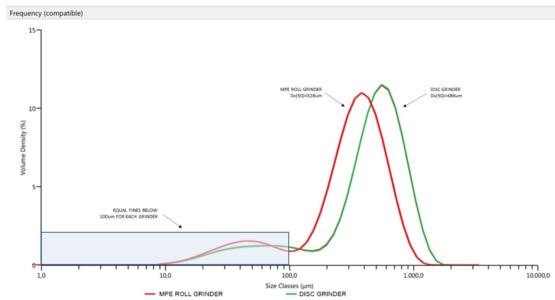Macinazione per Capsule di Caffè
Conosci la differenza tra macinatori a dischi e macinatori a rulli e come influisce sulle prestazioni delle tue capsule?
A seconda delle quantità che produrrai, ci sono tre fattori principali da considerare:
- Differenze nel Profilo di Macinatura
- Controllo della Densità
- Costanza
Differenze nel Profilo di Macinatura
- I macinatori a dischi offrono una sola regolazione, ovvero la distanza tra i dischi. La velocità o la velocità relativa dei dischi ha un effetto minimo sulla distribuzione delle dimensioni delle particelle. I macinatori a rulli hanno regolazioni indipendenti dello spazio e controllo della velocità differenziale su tutte le sezioni di macinatura (tipicamente 3 set di rulli di macinatura nel caso della macinatura per espresso); quindi, gli utenti possono manipolare il profilo di distribuzione delle particelle e la dimensione media di macinatura in modi diversi. Quando gli utenti desiderano un profilo di distribuzione delle particelle stretto con un minimo di fini, come nel caso delle capsule compatibili con Nespresso, i macinatori a rulli forniranno un profilo di macinatura con una dimensione media più fine e con meno polvere sotto i 100 micron rispetto ai macinatori a dischi.
- Inoltre, i macinatori a rulli sono più facili da mantenere freschi durante il funzionamento ed eliminano anche la maggior parte dell’attrito tra particelle durante la macinatura. Ciò comporta una minore introduzione di calore nel caffè da parte dei macinatori a rulli.
- Risultato
- I macinatori a rulli consentono un profilo di distribuzione delle particelle più netto e uniforme, che permette rese di estrazione di solidi più elevate utilizzando la stessa quantità di caffè e con tempi di infusione più costanti.
- Con i macinatori a rulli, gli operatori hanno il controllo sulla percentuale di fini sotto i 100 µm, quindi i tempi di infusione possono essere regolati al tempo desiderato.
- A causa della dimensione media di macinatura più piccola e del maggiore controllo sui fini (particelle sotto i 100 µm), le capsule NC prodotte con macinatori a rulli adeguati presentano anche più crema quando infuse.
Differenze nel Controllo della Densità
- Macinatore a Dischi
- Controllo della densità pari a zero
- Macinatori a Rulli
- Aumento della densità in caduta libera dal 0 al 45% utilizzando il Sistema di Densificazione Vortex MPE. Ciò consente agli utenti di normalizzare i volumi di densità apparente. Le tostature scure non devono essere compresse nelle capsule per raggiungere il peso in grammi; quindi, il flusso diventa più facile.
- La densificazione (compattazione), se eseguita correttamente, può ridurre ulteriormente i fini inferiori a 100 µm di circa l’1% inserendo i fini nelle fessure delle particelle più grandi. Ciò facilita ulteriormente il flusso dell’acqua nella macchina da caffè.
- Risultato
- Il controllo della densità offre agli utenti la possibilità di inserire più caffè in una capsula a un’altezza di riempimento costante. Se gli utenti desiderano inserire più di 6 grammi per capsula NC per ottenere un espresso più forte, è possibile farlo utilizzando il controllo della densità su tostature chiare e scure.
- Gli utenti possono regolare l’altezza di riempimento ottimale del caffè per vari gradi di tostatura, diversi volumi interni delle capsule e pesi in grammi desiderati.
Differenze di Costanza
- Macinatore a Rulli
- Costante dall’inizio alla fine e i fini possono essere controllati utilizzando gli spazi tra i rulli.
- Tempi di Infusione: Bassa varianza/costante
- Macinatori a Dischi
- Si surriscaldano dopo 20-25 minuti e i profili di macinatura cambiano, vengono prodotti più fini e gli operatori devono regolare.
- Tempi di Infusione: Alta varianza
Macinazione per Capsule Spiegata

Grafico delle Differenze di Profilo di Macinatura tra Macinatori a Dischi e a Rulli

Sistemi e Macinatori MPE per Monodose

Mini.Max Installato in un Impianto di Produzione di Capsule in Belgio
Vedi come il Mini.Max ha migliorato la produzione di capsule di caffè rispetto a tecnologie di macinazione inferiore.
Video dei Sistemi per Capsule di Caffè
Il Gruppo Sistemi MPE progetta sistemi per capsule di caffè in tutto il mondo.






